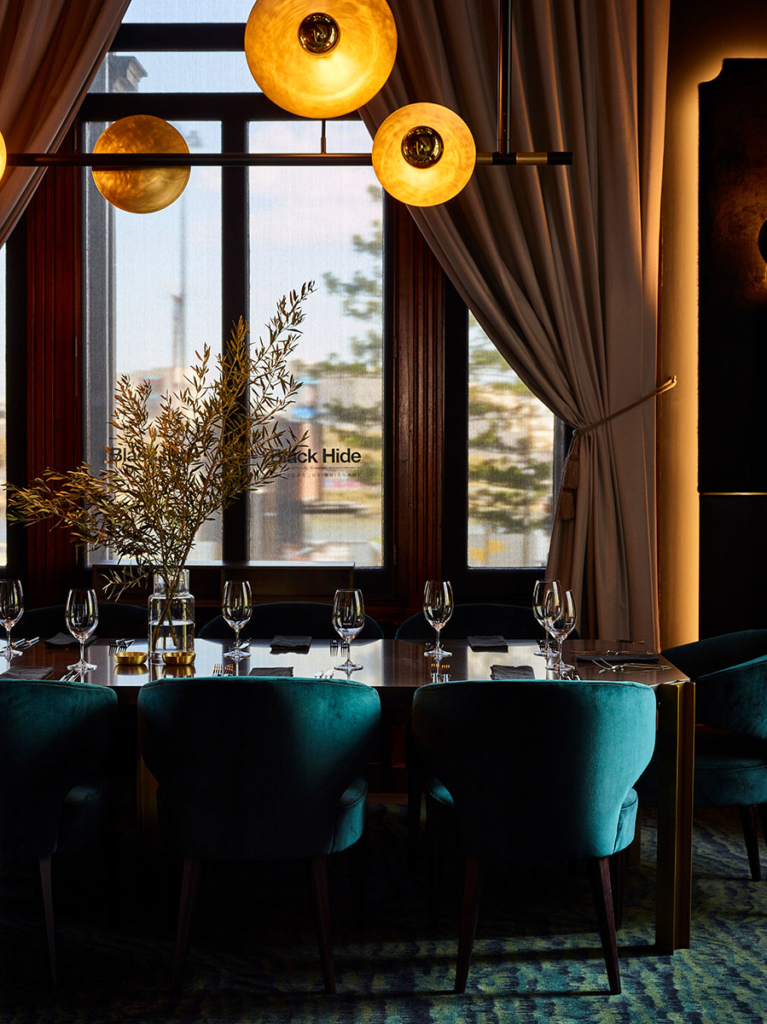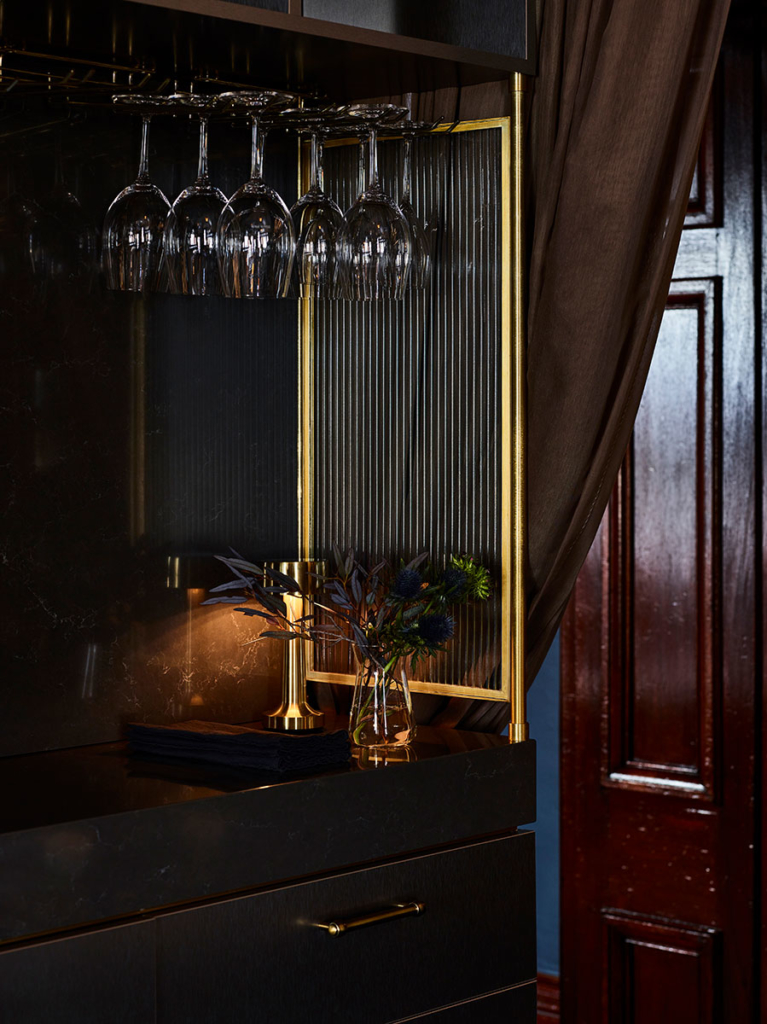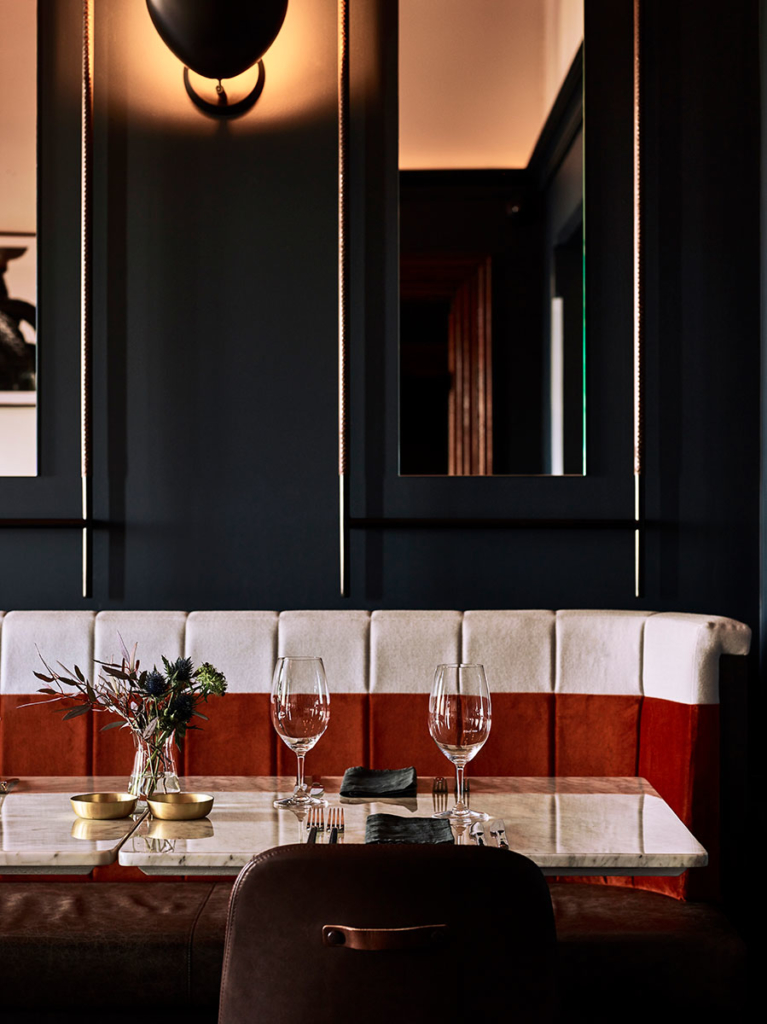
Text provided by the architects
PUSHING THE BOUNDARY OF TRADITIONAL STEAKHOUSE DESIGN; A GAMBARO FAMILY LEGACY CONTINUES IN A HERITAGE BUILDING
The Black Hide Steakhouse pushes the boundary of traditional steakhouse design. Positioned prominently within Brisbane’s iconic 19th century, Italianesque Treasury Building and featuring spectacular views across the Brisbane River, the project is emotive and dramatic in its approach.
Designed around the concept of paddock-to-plate, the space delivers a unique sensory dining experience for its diners. The design of the space is driven by the senses creating a layered and multi-faceted black label experience. Luxurious furnishings, plush fabrics, opulent, double height up-lit ceilings and large, boutique display cabinets of aged steak and wine all create a divinely rich atmosphere toying with the idea of ‘steak theatre’ and crafting a truly unique dining experience.
Featuring three distinct, separate dining rooms alike in grandeur and luxe, the restaurant seats 126 patrons and includes a 12-person private dining room which appears both simultaneously extravagant and intimate. Complementing the dark, moody, atmospheric internal space, the outdoor areas are light and softened with planters to bring the outdoors inside. Classic, chequerboard floors and relaxed finishes invite diners to relax with an aperitif or simply take in the spectacular city views.

The design brief for the Black Hide Steakhouse by Gambaro was to design and deliver a high-end steakhouse of international quality, inserted within an historic building. To deliver an outstanding concept for the client the team benchmarked the best steakhouses across the world, building upon existing concepts to surpass their findings with a superior execution.
The team were strongly inspired by all elements of the prime product of the well-known ‘Black Hide brand’ – meat; from the prior history of the site as an agricultural headquarters, knives and butchery as well all the bi-products of the cow. This inspiration was translated throughout all the spaces, where the feature of traditional, metal butchers hooks and meat cleavers were juxtaposed against sumptuous leather detailing, soft brushed brass features and lasso inspired shapes – creating unique and interesting moments throughout the restaurant.

To set the tone for the unique design narrative which runs throughout Black Hide, the team were exceptionally detail-orientated from start to finish. Focusing on each key detail, from the entry experience to how the food was plated, the colour palettes to bespoke electrical fittings, the entire concept was always tied back to the meat product. The open knife display with a sliding ladder reminiscent of an old library, the dry aged retail inspired meat display, the meat hook mirror details and cleaver handles in the bathrooms ensured the inspiration was carried through the entire space.
Located within Brisbane’s Treasury Building; the designers chose to embrace the buildings rich history. Celebrating the heritage elements, key features of the space were emphasized. The ornate architraves were accentuated by white paint to contrast against the midnight ink blue colour of the walls. The original fireplaces were enhanced as key features to the rooms and the surplus original floorboards were reinstalled to celebrate the tradition of the space.
An orchestration of the different senses, Black Hide is a multi-sensory adventure. Every element was carefully curated to subconsciously weave a memorable and multi-faceted experience; from the scent, the hum of background music, the lush and seductive tactile materials and the moody, atmospheric entrance which sets the tone for the fine dining experience within. A vaulted portal complete with custom lasso light fixture beckons the diner in; marble porcelain, dark timber and metal features envelop visitors whetting their appetite for the main event. The darker entry opens to a comparatively lighter interior, playing with the dilation of the eye.
Creating a unique experience, each room is themed in relation to the sense in which it relates. The Carving and Butchers Rooms focus on taste, touch inspires the Hide Room and hearing in the Parlour Room. The Paring Room is inspired by the smell of smoky decadent cocktails and natural aromas as they diffuse from the kitchen. The luxury private space, The Black Label Room, is tactile and sumptuous; full height drapery and textured wall panelling evoke feelings of elegance and indulgence.
Detailing was critical to the design process with each element carefully considered and meticulously hand-sketched. Acute attention to detail and inclusion of bespoke items is recurrent throughout the space.

Immediately linking the restaurant to its agricultural background, the host desk is a custom-stitched leather booth which effortlessly feels both indulgent and industrial. Comprised of a combination of timber, metal and glass with brass detailing, the open knife display behind the desk houses the 126 VIP clientele monogrammed steak knives.
The original timber flooring is layered with brass inserts and shaded pile carpets. Luxurious furnishings of marble, timber, leather and suede complement the rooms, with cosy banquette seating and lush drapery. Juxtaposing the modern with the traditional, the original fireplaces are paired with contemporary artworks above. Custom lighting creates a warm and authentic atmosphere which balances the solid, heritage timber doors, complete with custom-designed cleaver handles, accessing the private dining room.
The horseshoe shaped bar features gunmetal steel vertical fin details highlighted by concealed lighting and a distinctive black and white floor mosaic, a nod to traditional carveries. A dry aging meat cabinet with refined brass accents set against stone celebrates the hero product and provides visibility into the bar upon arrival.
Walls are cleverly used as distinctive dividers of space. The wine storage display, with solid timber base, metal surround and glass to all other faces, acts as a see-through divider and a double-sided mirror into the kitchen makes the diner a participant in the theatre of food.
comments